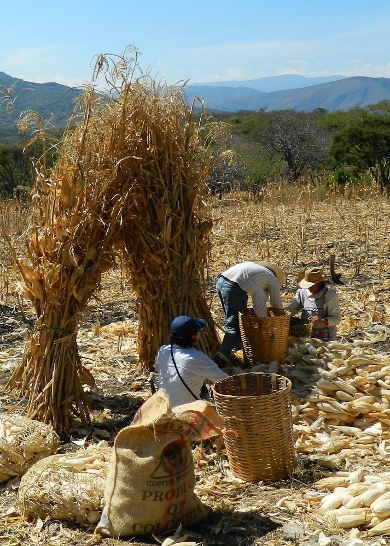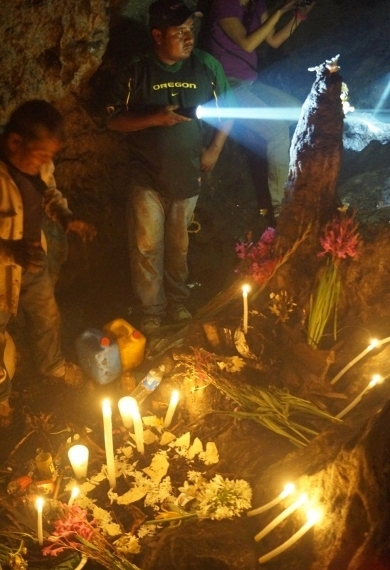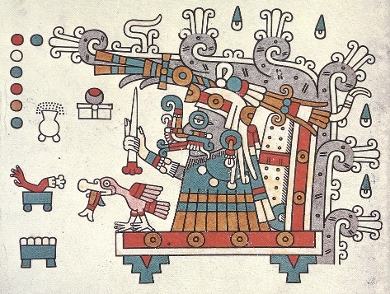Research project
The perception of time in the Ñuu Dzaui landscape, Oaxaca, Mexico.
1) How natural cycles and activities are interconnected for building the time in one community? 2) What perceptions of Ñuu Dzaui peoples about their landscape can be connected with precolonial times?
- Funding
-
 European Research Council (Advanced Grant 295434).
European Research Council (Advanced Grant 295434).
- Partners
We work in collaboration with some communities in the Ñuu Dzaui region: Yutanduchi, Chalcatongo, Yosonotu, San Miguel el Grande and Tlaxiaco
Short abstract
This research focusses on the inhabitants of the Ñuu Dzaui (Mixteca Alta) and their perception of time in relation to their surrounding landscape through specific activities. Additionally, it addresses the cultural continuity in this region: to better understand the precolonial societies, the knowledge and current activities of the local people are used in the analysis of the historical, archaeological and pictographic sources.

The work in the milpa (maize fields) is an activity that can be traced back to precolonial times, this is related with the rain season and at the same time with other livelihood and ritual’s activities that have other rhythms.

The ritual of petition for rain takes place in a cave called Vehe Davu (Rain House) and is very important for the construction of time and comunitas in the Ñuu Dzaui communities and at the same time, it gives meaning to an ancient sacred landscape, this ritual can help us to have a better understanding of Mesoamerican religion.


Contextualizing the issue
In Mexico, the archaeological and anthropological practice has generated a historical discontinuity. The first one focuses on the great precolonial civilizations that ended in 1521 because of the Spanish conquest, while the second one focuses on the communities of today, so both overlook the cultural continuity. Besides, most of their explanations are generated without an insider's understanding of the culture and therefore affected by the bias of the colonial sources. In this point lies the social importance of the research because for the Indigenous Peoples and in general for Mexican society it is very important to know ourselves as inheritors of a great civilization that is authentic and that has deep values, which from colonial times till today have been heavily devalued and discriminated against with pejorative terms that impose a hostile imagined identity. In this sense our research follows as its ethical guideline the United Nations Declaration of the Rights of Indigenous Peoples.
Main aim
The main aim of the research is to document and understand the perceptions and concepts that the Ñuu Dzaui people nowadays have about 'community time', that is constructed in the landscape. This in order to interpret the archaeological record and the landscape in terms of the complex relationships and the different process in which they were perceived and created. We will address this issue with three related activities - livelihood, rituals and orality - in their dimension of historical continuity.
The work in the milpa (maize field) and that of weaving palm are two activities of livelihood that can be traced back to precolonial times, these are related with the rainy and dry seasons respectively and at the same time with other livelihood and ritual activities that have other rhythms. In the same way the ritual petition of rain precedes the rainy season and the work in the milpa. These activities are crucial for the construction of time and communitas in the Ñuu Dzaui communities and, simultaneously, give meaning to an ancient sacred landscape.
To illustrate this with an example: when archaeologist mention the Rain God they mostly refer to his physical characteristics “in the past” and add little more than what was said by the chroniclers in the colonial period - this latter information generally is negative and pejorative. Our research shows that the Rain God is nowadays present in many parts in Mexico and is perceived very differently from the chronicles and documents written by the colonizers.
Why Leiden University? Often archaeology only focuses on materials. The approach developed in the department of Mesoamerica in the Faculty of Archaeology at Leiden University, is concerned with much more than just materials and focuses on the great knowledge, values and experience of peoples in a diachrone perspective of the “becoming” of a culture and a society. It focusses on cultural continuity, not just for mining ideas for interpreting the past, but as a general awareness, which leads to the active involvement of and collaboration with indigenous experts.
